Dear experts,
I'm building an active 3 way system (MTMWW) and now I'm in the final phase of tuning it: I've done extensive measurements for validation.
I would have your review to understand if I'm on the right path and I'm achieving the best outcome, and pros/cons of my solution.
What I would to do is something like John Lenard Burnett describes in his education articles (Crossovers: Basics)
Crossover points: 600Hz (2nd order BW) and 4000Hz (3rd order BW). Plan to crossover the 2 subs around 120Hz.
I’ve tried higher order (4th and 5th) but I can’t get a real flat curve and didn’t like the sound. I’m using a digital crossover (MiniDSP), so I’m free to change and/or EQ as much as is needed.
All the measurements are done with an UMIK-1 and verified thanks to the great REW forum help. All the .mdat files with the raw results are available
Cabinet stiffness test
Set up: 90dB, mic at 2cm from the cone, indoor, smoothed 1/48
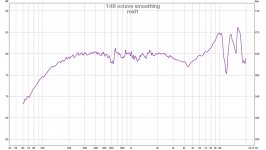
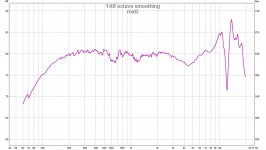
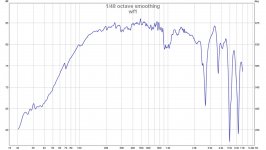
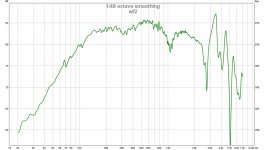
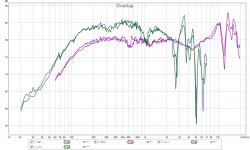
After overlap with the drivers makers FR, I didn’t notice any big differences, except in the woofers after 200Hz where I have a slightly faster roll off, as expected.
Based on that, I assume that I don’t have any standing waves and the box is stiff enough.
Comments?
Acoustic delay
Set up: 80dB, Audissey mic at 1 meter, indoor
I’ve used the loop feature in REW for calculate the acoustic delay, switching the mic because the UMIK is an USB one and it’s not possible to get the value. Below the inverted polarity measurements (80dB, mic at 1 meter, outdoor, gated) for validate the delay
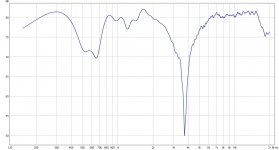
The delay input in the MiniDSP is what was measured.
This is the point where I’m less sure: the reversed spike is clear between T and M but is not exactly on the 4kHz mark, and between M and W there isn’t a clear spike, and the highest point is not on the 600Hz.
What do you think? Is it correct? I can easily modify the delay, so any recommendation here on how this FR should looks like is welcome!!
Single driver response
Set up: 80dB, mic at 1 meter, indoor, gated
Individual driver response
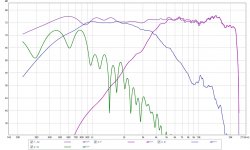
Frequency response
Set up: 80dB, mic at 1 meter, outdoor, gated
EQ: TW high shelf at 17k, 4dB gain, Q=1, WF low shelf at 150, 4dB gain, Q=1
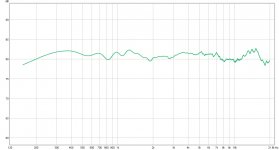
zoomed
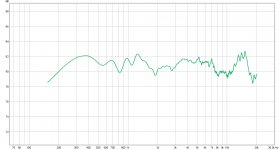
No gate, 1/48 smooth
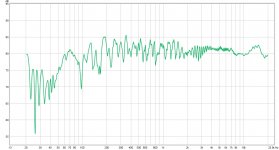
What do you think? Does the EQ make sense? Too much? Not too much?
I'm building an active 3 way system (MTMWW) and now I'm in the final phase of tuning it: I've done extensive measurements for validation.
I would have your review to understand if I'm on the right path and I'm achieving the best outcome, and pros/cons of my solution.
What I would to do is something like John Lenard Burnett describes in his education articles (Crossovers: Basics)
Crossover points: 600Hz (2nd order BW) and 4000Hz (3rd order BW). Plan to crossover the 2 subs around 120Hz.
I’ve tried higher order (4th and 5th) but I can’t get a real flat curve and didn’t like the sound. I’m using a digital crossover (MiniDSP), so I’m free to change and/or EQ as much as is needed.
All the measurements are done with an UMIK-1 and verified thanks to the great REW forum help. All the .mdat files with the raw results are available
Cabinet stiffness test
Set up: 90dB, mic at 2cm from the cone, indoor, smoothed 1/48





After overlap with the drivers makers FR, I didn’t notice any big differences, except in the woofers after 200Hz where I have a slightly faster roll off, as expected.
Based on that, I assume that I don’t have any standing waves and the box is stiff enough.
Comments?
Acoustic delay
Set up: 80dB, Audissey mic at 1 meter, indoor
I’ve used the loop feature in REW for calculate the acoustic delay, switching the mic because the UMIK is an USB one and it’s not possible to get the value. Below the inverted polarity measurements (80dB, mic at 1 meter, outdoor, gated) for validate the delay

The delay input in the MiniDSP is what was measured.
This is the point where I’m less sure: the reversed spike is clear between T and M but is not exactly on the 4kHz mark, and between M and W there isn’t a clear spike, and the highest point is not on the 600Hz.
What do you think? Is it correct? I can easily modify the delay, so any recommendation here on how this FR should looks like is welcome!!
Single driver response
Set up: 80dB, mic at 1 meter, indoor, gated
Individual driver response

Frequency response
Set up: 80dB, mic at 1 meter, outdoor, gated
EQ: TW high shelf at 17k, 4dB gain, Q=1, WF low shelf at 150, 4dB gain, Q=1

zoomed

No gate, 1/48 smooth

What do you think? Does the EQ make sense? Too much? Not too much?
You seem to have gotten a flat on-axis response. That's good. What does the off-axis response look like out to 60 degrees horizontally and +/-30 degrees vertically? It's important to look for peaks and dips over this angle range, because the sound that you hear when you listen to the loudspeaker is NOT just the direct, on-axis sound. The room returns much of the off-axis sound to the listening position, and if there are major off-axis flaws the tonal character will be influenced in a negative way.
What is the gate? I suspect it is not long enough to have valuable info in the W-M crossover region.
Ralf
PS what is the reason for the 600 Hz crossover point? It seems a little high, I would opt for the baffle step point.
Ralf
PS what is the reason for the 600 Hz crossover point? It seems a little high, I would opt for the baffle step point.
Many get enamoured of the 4th order default crossover slopes in miniDSP, but few like them. 🙂 2nd to third order crossovers end up being far more useful. Having the ability to delay the driver outputs is a very good thing and helps using much simpler crossover slopes. If you use 2nd order, time delayed filters you may have to invert the midrange though. Don't be afraid of it. 🙂
I think the hump between 10k and 20 k needs to be dealt with. What tweeter are you using? Is it a mid-range AMT by any chance?
Personally I go for a falling response, a-la B&K or thereabouts. I think perfectly flat seems very bright and thin, but regardless that tweeter hump could be pretty wearing on the ear.
Best,
Erik
I think the hump between 10k and 20 k needs to be dealt with. What tweeter are you using? Is it a mid-range AMT by any chance?
Personally I go for a falling response, a-la B&K or thereabouts. I think perfectly flat seems very bright and thin, but regardless that tweeter hump could be pretty wearing on the ear.
Best,
Erik
Second part of the post... Sorry can't do before because the admin has to approve...
Phase
Same set up
Here is where I’ve really no idea if I’m right or not, and can’t find any good before/after example… every comment and links are more than welcome
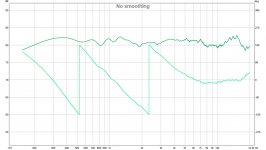
Off axis
Set up: 80dB, mic at 1 meter, indoor, gated
Purple: on axis
Red: 15 deg
Green: 60 deg
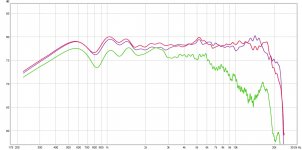
Do you think it’s ok?
Thanks in advance to everybody!
cheers
Phase
Same set up
Here is where I’ve really no idea if I’m right or not, and can’t find any good before/after example… every comment and links are more than welcome

Off axis
Set up: 80dB, mic at 1 meter, indoor, gated
Purple: on axis
Red: 15 deg
Green: 60 deg

Do you think it’s ok?
Thanks in advance to everybody!
cheers
Charlie,
thanks!
I did just the 15 deg and 60 deg horizontally so far, as per my post: is better if I validate the +/- 30 deg vertically as well?
Ralf,
It's 5.5ms, good for a 154Hz frequency resolution based on REW. This window is applied only to the "Outdoor" response, inside it's 2.5ms (286Hz resolution)
I followed the John Lenard article. Based on my setup, the tweeter covers 4k to 20k (~2.5 octaves), mids 4k to 600 (that should be 500 but I get better with 600 - ~3 octaves here), the woofers from 600 to 120 (2 octaves). I'm planning to fill in the system with 2 quality subs. What do you think?
Erik,
Strange that SB declared it flat on axis until ~25k…
Do you think is important to fix it, since it’s a couple of dB on a very high frequency?
Thanks to all for review my project and looking forward to more comments!
cheers
You seem to have gotten a flat on-axis response. That's good.
thanks!
What does the off-axis response look like out to 60 degrees horizontally and +/-30 degrees vertically?
I did just the 15 deg and 60 deg horizontally so far, as per my post: is better if I validate the +/- 30 deg vertically as well?
Ralf,
What is the gate? I suspect it is not long enough to have valuable info in the W-M crossover region
It's 5.5ms, good for a 154Hz frequency resolution based on REW. This window is applied only to the "Outdoor" response, inside it's 2.5ms (286Hz resolution)
what is the reason for the 600 Hz crossover point?
I followed the John Lenard article. Based on my setup, the tweeter covers 4k to 20k (~2.5 octaves), mids 4k to 600 (that should be 500 but I get better with 600 - ~3 octaves here), the woofers from 600 to 120 (2 octaves). I'm planning to fill in the system with 2 quality subs. What do you think?
Erik,
I just wanted and active system at the beginning, but a lot of people told me “use 4 that is better”. What I’ve found is that I can’t get a flat response (anyway inside the +/- 3dB…) but the sound was too “flat”, and looks like when an orchestra warm up… many people playing good notes but completely disconnected from each others…Many get enamoured of the 4th order default crossover slopes in miniDSP, but few like them. 🙂
Right: the delay is added as per the REW loop measurement and the tweeter and mids are reversed in polarity 🙂If you use 2nd order, time delayed filters you may have to invert the midrange though.
I’ve got the same issue, and in the measurement forum they told me that is due to the “phase shield” in front of the tweeter. I’m using a SB26ADC-C000-4. As you can see, I’ve already EQ above 17k: I can do more but I don’t know if that could stress too much the driver.I think the hump between 10k and 20 k needs to be dealt with. What tweeter are you using? Is it a mid-range AMT by any chance?
Strange that SB declared it flat on axis until ~25k…
Do you think is important to fix it, since it’s a couple of dB on a very high frequency?
Do you mean B&W? If yes I understand what you mean. I get the impression on what you are saying when I tried the 4th order XO. About the “body”, it was "thin" in the testing position: before doing any changes, I put the speaker on the floor, in a potential listening position, and the floor reflection change it very much, filling what I think wasn’t there before. I’ve reduced the LF EQ by 1dB (to the 4dB gain now) because they became too prominent. Anyway, this is a subjective opinion not confirmed by any measurements.Personally I go for a falling response, a-la B&K or thereabouts. I think perfectly flat seems very bright and thin, but regardless that tweeter hump could be pretty wearing on the ear.
Thanks to all for review my project and looking forward to more comments!
cheers
That is odd from an SB tweeter!
No, I would never suggest you follow a Bowers and Wilkins response! 🙂 I meant Bruel & Kjaer.... drat have to find out how to spell it. 🙂 For a variety of reasons too smart for me to recite, flat is usually not considered optimal. You can do more research on the subject, but here is the curve B&K proposed on the subject.
No, I would never suggest you follow a Bowers and Wilkins response! 🙂 I meant Bruel & Kjaer.... drat have to find out how to spell it. 🙂 For a variety of reasons too smart for me to recite, flat is usually not considered optimal. You can do more research on the subject, but here is the curve B&K proposed on the subject.
An externally hosted image should be here but it was not working when we last tested it.
Erik,
Do you think the tweeter is damaged? I have another one to try...
is that the so called "house curve"? If yes I'm perfectly aligned with you: a flat response from testing and then the house curve (similar to the one from B&K) with the speakers in listening position to achieve the best result.
If not, is there any speakers in production that use it?
thanks!
cheers
That is odd from an SB tweeter!
Do you think the tweeter is damaged? I have another one to try...
flat is usually not considered optimal. You can do more research on the subject, but here is the curve B&K proposed on the subject.
is that the so called "house curve"? If yes I'm perfectly aligned with you: a flat response from testing and then the house curve (similar to the one from B&K) with the speakers in listening position to achieve the best result.
If not, is there any speakers in production that use it?
thanks!
cheers
I don't know if it's damaged, I'd have to see the un-eqed tweeter. It could be a result of the other work you are doing. I personally like that top octave smooth as glass, but that's me.
Yes, I think that's what it's called. There are several takes on it. I prefer a bump around 100-200 Hz, down to 1kHz and then more or less flat to within a couple of dB. I don't like the top octave to descend, but some do and lots of tweeters have that built in. The overall balance makes this work.
Since I have only made 2-way monitors, I measure in place, and design the crossover accordingly. Makes my life a lot easier. Hard to do with 3-way monitors and crossover points below 500 Hz though. On the other hand, I am not quite sure how flat in measurement translates to the EQ that I would want. 🙂 I'm sure I'll get to reading about that eventually.
Yes, I think that's what it's called. There are several takes on it. I prefer a bump around 100-200 Hz, down to 1kHz and then more or less flat to within a couple of dB. I don't like the top octave to descend, but some do and lots of tweeters have that built in. The overall balance makes this work.
Since I have only made 2-way monitors, I measure in place, and design the crossover accordingly. Makes my life a lot easier. Hard to do with 3-way monitors and crossover points below 500 Hz though. On the other hand, I am not quite sure how flat in measurement translates to the EQ that I would want. 🙂 I'm sure I'll get to reading about that eventually.
Erik,
below the EQ and normal (amber)
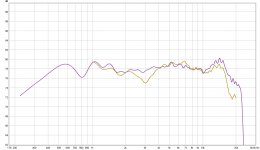
whatching it now looks like better without EQ... I was trying to limit that 17k -6dB...
I had the same idea at the beginning but ended up to do a "neutral" system and then tune it in the listening position. I think I have the tools (REW + MiniDSP + UMIK1) to do that 🙂
thanks!
cheers
below the EQ and normal (amber)

whatching it now looks like better without EQ... I was trying to limit that 17k -6dB...
Since I have only made 2-way monitors, I measure in place, and design the crossover accordingly. Makes my life a lot easier. Hard to do with 3-way monitors and crossover points below 500 Hz though. On the other hand, I am not quite sure how flat in measurement translates to the EQ that I would want. 🙂 I'm sure I'll get to reading about that eventually.
I had the same idea at the beginning but ended up to do a "neutral" system and then tune it in the listening position. I think I have the tools (REW + MiniDSP + UMIK1) to do that 🙂
thanks!
cheers
Try this.
Use 2 PEQ's. First, centered at 5kHz. Cut 1.5 dB. Adjust width until 3kHz to 9 kHz range is equal to 2 kHz. This is a very broad filter which should leave the top octave resonance sticking out like a sore thumb. Second PEQ about 13kHz, cut 2 dB. Make this one much narrower.
Best,
Erik
Use 2 PEQ's. First, centered at 5kHz. Cut 1.5 dB. Adjust width until 3kHz to 9 kHz range is equal to 2 kHz. This is a very broad filter which should leave the top octave resonance sticking out like a sore thumb. Second PEQ about 13kHz, cut 2 dB. Make this one much narrower.
Best,
Erik
So I tried this in OmniMic. It works pretty well. From 2kHz to about 18kHz it brings the spread down from about 4 dB to 2 dB. Below 2kHz you can EQ or rely on a high pass filter to take care of the remaining hump for you.

F1 = 5kHz, Q=0.9, -1.5 dB
F2 = 14 kHz, Q=2.6, -2.9 dB
Here is the equivalent REW Biquad file:
biquad1,
b0=0.9572749635577792,
b1=-1.1592790377334240,
b2=0.5039642836455661,
a1=1.1592790377334240,
a2=-0.4612392472033453,
biquad2,
b0=0.9489075713648745,
b1=0.4244664389762986,
b2=0.6911048118357650,
a1=-0.4244664389762986,
a2=-0.6400123832006395,
biquad3,
b0=1.0000000000000000,
b1=-1.8614084445321080,
b2=0.8774704646235392,
a1=1.8614084445321080,
a2=-0.8774704646235392,
biquad4,
b0=1.0000000000000000,
b1=-1.8614084445321080,
b2=0.8774704646235392,
a1=1.8614084445321080,
a2=-0.8774704646235392,
biquad5,
b0=1.0000000000000000,
b1=-1.8614084445321080,
b2=0.8774704646235392,
a1=1.8614084445321080,
a2=-0.8774704646235392,
biquad6,
b0=1.0000000000000000,
b1=-1.8614084445321080,
b2=0.8774704646235392,
a1=1.8614084445321080,
a2=-0.8774704646235392,
F1 = 5kHz, Q=0.9, -1.5 dB
F2 = 14 kHz, Q=2.6, -2.9 dB
Here is the equivalent REW Biquad file:
biquad1,
b0=0.9572749635577792,
b1=-1.1592790377334240,
b2=0.5039642836455661,
a1=1.1592790377334240,
a2=-0.4612392472033453,
biquad2,
b0=0.9489075713648745,
b1=0.4244664389762986,
b2=0.6911048118357650,
a1=-0.4244664389762986,
a2=-0.6400123832006395,
biquad3,
b0=1.0000000000000000,
b1=-1.8614084445321080,
b2=0.8774704646235392,
a1=1.8614084445321080,
a2=-0.8774704646235392,
biquad4,
b0=1.0000000000000000,
b1=-1.8614084445321080,
b2=0.8774704646235392,
a1=1.8614084445321080,
a2=-0.8774704646235392,
biquad5,
b0=1.0000000000000000,
b1=-1.8614084445321080,
b2=0.8774704646235392,
a1=1.8614084445321080,
a2=-0.8774704646235392,
biquad6,
b0=1.0000000000000000,
b1=-1.8614084445321080,
b2=0.8774704646235392,
a1=1.8614084445321080,
a2=-0.8774704646235392,
Attachments
Last edited:
Well, don't I feel like an idiot! 🙂 I got the two traces reversed.
Still, I think you may benefit more from cuts than boosts. Try out similar ideas, or add the two suggestions I made to your EQ'd version.
Still, I think you may benefit more from cuts than boosts. Try out similar ideas, or add the two suggestions I made to your EQ'd version.
Last edited:
I was trying to limit that 17k -6dB...
Independent measurements of the SB26ADC-C000-4 from HOBBY HiFi and Audio Gurman (http://www.audiogurman.com/images/SBacoustics/SB26ADC/SB26ADC_0.jpg) confirm a very flat response up to 17 kHz. What you see is more likely the response of your own measurement chain (microphone and amplifier) which seems to roll-off with a hump at 15 kHz. Of course it doesn't make sense to equalize that.
In order to achieve a good vertical dispersion a low crossover frequency is essential in an MTM speaker. Your tweeter is well suited for a crossover at 2 kHz, so take advantage of it.

Erik,
thanks for spend time on this issue. What I like is your approach, that is "lowering" instead of "gaining". I will use for other smaller issues that I have!
Dissi,
thanks for the link
after your post, I did some investigation and you are right, this could be the mic roll off, even if they provide the calibration file... I will remove all the EQ on the tweeter
thanks!
cheers
thanks for spend time on this issue. What I like is your approach, that is "lowering" instead of "gaining". I will use for other smaller issues that I have!
Still, I think you may benefit more from cuts than boosts. Try out similar ideas, or add the two suggestions I made to your EQ'd version.
Dissi,
thanks for the link
Independent measurements of the SB26ADC-C000-4 from HOBBY HiFi and Audio Gurman (http://www.audiogurman.com/images/SBacoustics/SB26ADC/SB26ADC_0.jpg) confirm a very flat response up to 17 kHz. What you see is more likely the response of your own measurement chain (microphone and amplifier) which seems to roll-off with a hump at 15 kHz. Of course it doesn't make sense to equalize that.
after your post, I did some investigation and you are right, this could be the mic roll off, even if they provide the calibration file... I will remove all the EQ on the tweeter
thanks!
cheers
- Status
- Not open for further replies.
- Home
- Loudspeakers
- Multi-Way
- 3 way active speaker tuning that needs experts review
